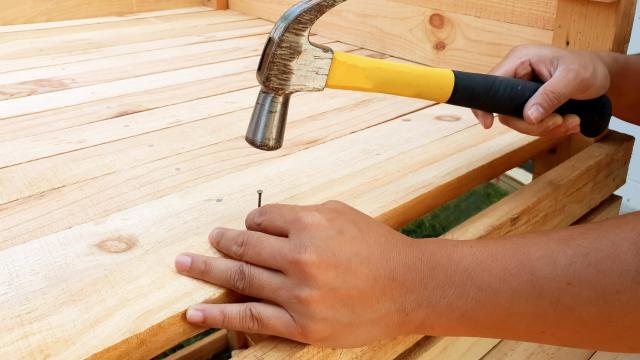Every craftsperson has their own unique way of doing things. Ask a question about a particular tool or method, and you’re likely to get as many different answers and suggestions as there are pros in the room. Some tricks are more useful than others, though — here are some of the best I know, from how to unstick a nut from its bolt, to how to (safely) find all the nails or screws strewn around your workspace.
How to unstick metal hardware
If you’ve got a nut that’s stuck on its bolt, you can use pencil lead as a lubricant. Oils can stick to dust and cause residue to build up on the surfaces of nuts and bolts. But graphite — the material that pencil lead is made from — is a great dry lubricant that won’t cause gooey buildup on your parts. This method can also work on locks, doorknobs, and set screws. Just scratch the pencil across the threads of the bolt or the inside of the nut, and then work the nut onto or off of the threads.
How to use a hammer more safely
For pain-free nail hammering, use a “finger-saver” made from a few different household materials. To hold smaller nails like finish nails, you can use a scrap of cardboard or a food container lid — just make a hole in your material with the nail you intend to use and then put your nail through the hole as a holder. Then, you can keep the nail straight with your fingers a few inches from where your hammer will hit. For larger sized nails, you can use a bobby pin to hold your nail and keep your fingers clear.
How to sand any hard-to-reach spots
Sanding surfaces that are multiplanar or curved can be challenging. A regular orbital sander or sanding block won’t reach all the spots you need to get to. For tricky tight spots, you can use objects other than traditional sanding blocks to reach any tough places you need to smooth out. For corners and thin surfaces, you can wrap sandpaper around a tongue depressor or a paint stir stick. For the interior of a curved surface, you can use a pencil, a screwdriver, or a roller handle. For larger diameter curves, a three- to four-inch section of a PVC pipe or a pool noodle works well. If you’re having trouble getting your paper to stay put, you can glue it or double stick tape it onto your makeshift block.
How to unstick a stuck screw
Stuck screws can be a real hassle. If the head of the screw you want to remove is starting to get stripped, you can try placing a sturdy rubber band over top of the head of the screw and pushing your screw gun through the rubber. Sometimes, this will give you just enough grip to get it going. If the head of your screw is filled with paint, you can try putting a screwdriver in the slot on the head and tapping with a hammer to remove some of the paint so that you can grip the screw with your driver. For a screw that is bent, try using a pair of vice grips to grab the screw and turn it to remove it.
How to make a DIY drill depth stop
If you need to drill a hole to a specific depth and you don’t have a stop collar, you can use a piece of painter’s tape wrapped around the bit at the height you want to stop drilling. Give it a few snug wraps so that you’ll be able to feel it bumping your surface. Note that this method isn’t foolproof. If you push hard enough, you can push past your homemade stop, so it requires some finesse.
How to pull a nail without leaving a mark
To pull nails from a surface without creating marks from your hammer, use a scrap of wood, a piece of cardboard, or a sponge to push against. Place your buffer material between the hammer and the surface, and then use the claw side of the hammer to pull your nail.
How to find all those dropped nails
To keep screws and nails from causing a hazard on the floor when they get dropped, use a magnet to pick them up. Sure, there are specific tools for this, but really any magnet will do. Double stick tape on the end of a roller pole or tie a magnet to a string to save your back from pain. For easy removal, use a ziplock bag or piece of butcher paper between the magnet and the hardware. Pull your cover off over the trash can or container. This trick can also attract metal shavings, so gloves are a must to protect your hands.

Leave a Reply
You must be logged in to post a comment.